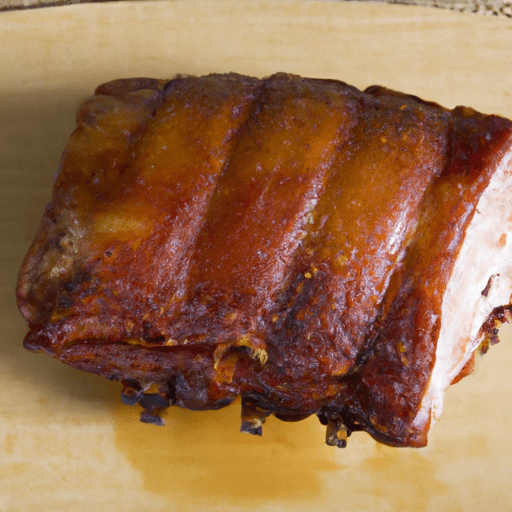All You Need to Know About Boneless Pork Rib Roast
If you’re a fan of succulent, flavorful pork, then you’re in for a treat with boneless pork rib roast. This delicious cut of meat is incredibly versatile, making it a favorite among home cooks and professional chefs alike. In this blog post, we’ll dive into the wonderful world of boneless pork rib roast, covering everything from its taste profile and common uses in cooking to its nutritional value and fascinating history. So let’s get started!
Taste and Texture
Boneless pork rib roast is a cut that comes from the rib section of the pig. As the name suggests, it is a boneless cut, which means it is easy to work with and makes for hassle-free cooking. The meat from this roast is known for its incredible tenderness, juiciness, and succulence. It has a rich, savory flavor with a perfect balance of fat and lean meat, offering a melt-in-your-mouth experience that will leave you craving more.
Common Uses in Cooking
Boneless pork rib roast lends itself well to a variety of cooking methods, making it a versatile choice for any culinary creation. The natural tenderness of the meat makes it perfect for roasting, where it can be seasoned with herbs and spices to bring out its mouthwatering flavors. It can also be grilled to perfection, creating a smoky and charred exterior while retaining its juiciness. For those looking to experiment, slow-cooking this roast can result in an incredibly tender and flavorful pulled pork, perfect for sandwiches, tacos, or even served over rice.
Nutritional Value
Like other cuts of pork, boneless pork rib roast offers a range of essential nutrients. It is a great source of high-quality protein, which is vital for building and repairing tissues within the body. It also provides important vitamins and minerals, including thiamine, niacin, vitamin B6, iron, and zinc. However, it’s worth noting that this cut can have a higher fat content compared to leaner cuts of pork. So, it’s always a good idea to enjoy it in moderation and balance it with a variety of other nutritious foods.
History and Interesting Facts
Pork has been a popular protein source for centuries, and the boneless pork rib roast has played a significant role in various culinary traditions around the world. In the United States, for example, it is often associated with holiday feasts, particularly during Thanksgiving and Christmas. In many Asian cuisines, this cut is used in traditional dishes, such as char siu (Chinese barbecue pork) or Korean-style grilled pork ribs. These preparations showcase the versatility and wide-reaching influence of boneless pork rib roast.
Did you know that the rib section is home to some of the most flavorful cuts of meat on a pig? The marbling of fat within the muscle fibers creates a more tender and succulent experience, making it a top choice for meat enthusiasts. When choosing your boneless pork rib roast, look for a well-trimmed piece with just the right amount of fat for optimal flavor and juiciness.
Conclusion
Boneless pork rib roast is a culinary treasure that deserves a place in every meat lover’s kitchen. Its tender and juicy texture, along with its rich flavor, makes it a delight to cook and savor. Whether roasted, grilled, or slow-cooked, this cut is sure to impress with its versatility and mouthwatering taste. So, the next time you’re planning a special meal or gathering, consider adding boneless pork rib roast to your menu for a truly memorable dining experience.
Origin
- Boneless pork rib roast is a cut of meat that comes from the rib area of the pig.
- It is commonly known as “pork back ribs” or “rack of pork” in some regions.
Common Uses
- Boneless pork rib roast is often roasted whole or sliced into individual ribs.
- It can be marinated or seasoned with various spices, herbs, or sauces before cooking.
- It is a popular choice for grilling, barbecuing, or slow cooking methods, such as braising.
Nutritional Benefits
- Boneless pork rib roast is a good source of high-quality protein, containing all essential amino acids required by the body.
- It is also a good source of various vitamins and minerals, including thiamin, selenium, zinc, phosphorus, and iron.
- However, it is important to note that the fat content and calorie count can vary depending on the level of marbling and the cooking method used.
Unique Properties and Historical Significance
- Boneless pork rib roast is known for its tender and juicy texture due to the marbling of fat within the meat.
- The use of pork ribs in cooking can be traced back to ancient times, with evidence of their consumption in different cultures around the world.
- Various cuisines have their own distinct preparations for pork ribs, such as barbecue ribs in the United States, char siu in Chinese cuisine, and tiropita in Greek cuisine.
Please note that boneless pork rib roast is also commonly referred to as “pork loin back ribs” or “center-cut pork loin roast.”




Use the share button below if you liked it.
It makes me smile, when I see it.